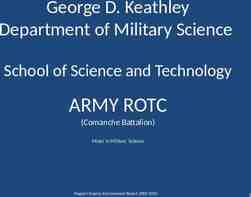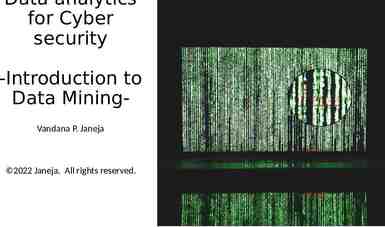CHAPTER 1 The Orientation and History of the Fire Service
53 Slides1.64 MB
CHAPTER 1 The Orientation and History of the Fire Service
Fire Fighter I Objectives List five guidelines for successful fire fighter training. Describe the general requirements for becoming a fire fighter. Outline the roles and responsibilities of a Fire Fighter I. Describe the common positions of fire fighters within the fire department.
Fire Fighter I Objectives Describe the specialized response roles within the fire department. Explain the concept of governance and describe how the fire department’s regulations, policies, and standard operating procedures affect it.
Fire Fighter I Objectives Locate information in departmental documents and standard operating procedures. List the different types of fire department companies and describe their functions. Describe how to organize a fire department in terms of staffing, function, and geography.
Fire Fighter I Objectives Explain the basic structure of the chain of command within the fire department. Define the four basic management principles used to maintain organization within the fire department. Explain the evolution of the methods and tools of firefighting from colonial days to the present.
Fire Fighter I Objectives Explain how building codes prevent the loss of life and property. Describe the evolution of funding for fire department services.
Fire Fighter II Objectives Outline the responsibilities of a Fire Fighter II. Describe the roles of a Fire Fighter II within the fire department.
Introduction Training to become a fire fighter is not easy. Fire fighters are challenged both physically and mentally. Fire fighter training will expand your understanding of fire suppression.
Fire Fighter Guidelines Be safe. Follow orders. Work as a team. Think! Follow the Golden Rule.
Fire Fighter Qualifications Age requirements – Most departments require that candidates be between the ages of 18 and 21 years. Education requirements – Most departments require a minimum of a high school diploma or equivalent.
Fire Fighter Qualifications Medical requirements – Medical evaluations are often required before training can begin. – Medical requirements for fire fighters are specified in NFPA 1582, Standard on Comprehensive Operational Medical Program for Fire Departments.
Fire Fighter Qualifications Physical fitness requirements – Physical fitness requirements ensure that fire fighters have the strength and stamina needed. Emergency medical requirements – Departments may require fire fighters to be certified as an Emergency Medical Responder, Emergency Medical Technician (EMT)–Basic, or Paramedic.
Roles and Responsibilities for Fire Fighter I Properly don and doff PPE. Hoist hand tools using appropriate ropes and knots. Understand and correctly apply appropriate communication protocols. Use self-contained breathing apparatus (SCBA).
Roles and Responsibilities for Fire Fighter I Respond on apparatus to an emergency. Establish and operate safely in emergency work areas. Force entry into a structure. Exit a hazardous area safely as a team. Set up ground ladders safely and correctly.
Roles and Responsibilities for Fire Fighter I Attack a passenger vehicle fire, an exterior Class A fire, and an interior structure fire. Conduct search and rescue in a structure. Perform ventilation of an involved structure. Overhaul a fire scene.
Roles and Responsibilities for Fire Fighter I Conserve property with salvage tools. Connect an engine to a water supply. Extinguish Class A, Class B, Class C, and Class D fires. Illuminate an emergency scene. Turn off utilities.
Roles and Responsibilities for Fire Fighter I Combat a ground cover fire. Perform fire safety surveys. Clean and maintain equipment.
Roles and Responsibilities for Fire Fighter II Prepare reports. Communicate the need for assistance. Coordinate an interior attack line team. Extinguish an ignitable liquid fire. Control a flammable gas cylinder fire.
Roles and Responsibilities for Fire Fighter II Protect evidence of fire cause and origin. Assess and disentangle victims from motor vehicle collisions. Assist special rescue team operations. Perform a fire safety survey.
Roles and Responsibilities for Fire Fighter II Present fire safety information. Maintain fire equipment. Perform annual service tests on fire hose. Insert Figure 1-3
General Roles Within the Department Fire apparatus driver/operator Company officer Safety officer Training officer Incident commander Fire marshal/inspector/investigator
General Roles Within the Department Fire and life safety education specialist 911 dispatcher/telecommunicator Apparatus maintenance personnel Fire police Information management Public information officer Fire protection engineer
Specialized Response Roles Aircraft/crash rescue fire fighter Hazardous materials technician Technical rescue technician SCUBA dive rescue technician Emergency Medical Services (EMS) personnel – EMT, Advanced EMT, and Paramedic
Working with Other Organizations Fire departments need to interact with other organizations in the community.
Working with Other Organizations Incident Command System (ICS) – Unified command system – Controls multiple agencies at an incident
Fire Department Governance Regulations – Detailed rules that implement a law passed by a governmental body Policies – Outline what is expected in stated conditions – Issued by a department to provide guidelines for its actions
Fire Department Governance SOPs – Provide specific information on actions that should be taken to accomplish a task – Standard operating guidelines (SOGs) are not as strict.
Fire Department Governance
Company Types Engine Truck
Company Types Rescue Wildland/brush Hazardous materials Emergency Medical Services (EMS)
Other Views of Fire Service Organization Staffing – Department must have sufficient trained personnel available Function – Bureau or office – Apparatus type Geography
Chain of Command Structure for managing the department and the fire-ground operations Ranks may vary by department, but the concept is the same.
Chain of Command
Source of Authority Source of authority – Local governments – Sometimes state and federal governments Fire chief accountable to the governing body
Basic Principles of Organization Discipline – Guiding and directing fire fighters Division of labor – Makes individual responsible for completing the assigned task – Prevents duplicate job assignments
Basic Principles of Organization Unity of command – Establishes a direct route of responsibility from the chief to the fire fighter
Basic Principles of Organization Span of control – Number of people one person can supervise effectively
History of the Fire Service Romans created first fire department, the Familia Publica. – First paid department in the United States was Boston (established in 1679). – Ben Franklin started the first volunteer department in the United States in Philadelphia in 1735.
The Great Chicago Fire Began October 8, 1871 Burned for 3 days Damage totals: – 200 million – 300 dead – 90,000 homeless
The Peshtigo Fire Flash forest fire occurred at same time as the Great Chicago Fire – – – – “Tornado of fire” 1000 ft high and 5 miles wide 2400 square miles (m2) of forest land burned 2200 dead Several small communities destroyed
Building Codes History of building codes – Egyptians used codes to prevent collapse. – Colonial communities had few codes. – Present codes address construction materials and “built-in” protection.
Building Codes Codes are written by national organizations. – National Fire Protection Association (NFPA) Volunteer committees research and develop proposals. The consensus document is presented to the public.
Training and Education Today’s fire fighters operate high-tech, costly equipment. Fire fighters need to continually sharpen their skills and increase their knowledge.
Fire Equipment Colonial fire fighters had buckets, ladders, and fire hooks. Hand-powered pumpers were developed in 1720. Steam-powered pumpers were developed in 1829.
Fire Equipment Present-day equipment – Single apparatus used for several purposes Fire hydrants developed in 1817 First public call boxes developed in 1860
Communications Fire wardens and night watchmen used during colonial period Telegraph alarm systems developed in late 1800s Present day – Hardwired and cellular telephones – Computer-aided dispatch facilities
Communications Fire-ground communications – Early days: Chief’s trumpet, now a symbol of authority – Present: Two-way radios
Paying for Fire Service In early times, insurance companies paid fire departments for service. Career departments are generally funded through local tax funds.
Fire Service in the United States Today About 1.1 million fire fighters 75% of career fire fighters serve communities of 25,000 or larger. Half of volunteers serve rural areas with populations of 2500 or smaller. Approximately 30,000 fire departments
Summary Be safe, follow orders, work as a team, think, and follow the Golden Rule. Training and performance qualifications for fire fighters are specified in NFPA 1001. Fire Fighter I works under direct supervision; Fire Fighter II works under general supervision.
Summary You may assume several roles in the fire department. Most large fire departments have teams of specialized fire fighters. When multiple agencies work together at an incident, a unified command must be established.
Summary Governance is the process by which an organization exercises authority. A fire department includes many different types of companies. The chain of command is fire fighter, lieutenant, captain, battalion chief, assistant or division chief, and chief of the department.
Summary The management principles of the fire service are discipline, division of labor, unity of command, and span of control. Building codes govern construction materials. It is helpful to study the past and present fire service.


























































